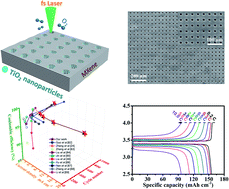Bifunctional effect of laser-induced nucleation-preferable microchannels and in situ formed LiF SEI in MXenes for stable lithium-metal batteries†
Abstract
Lithium (Li) metal is considered to be the ultimate choice of anode for high energy density lithium-based batteries. However, the uncontrollable dendrite growth, in particular at large current rates, hinders its practical applications. Herein, a novel MXene/TiO2 membrane with aligned microchannels as the lithium host is fabricated using a femtosecond laser, with numerous lithiophilic sites (TiO2) spatial-precisely synthesized on the channel walls. Benefiting from the exposed nanometer-scale edges of the MXene, a favorable Li+ ion migration into the channels is achieved by the well-manipulated electric field, thus resulting in preferential Li deposition inside the microchannels. Moreover, a lithium fluoride (LiF) reinforced SEI is generated on the top surface of the host upon electrochemical cycling thanks to the built-in fluorine terminals in the MXene. As a result, a long lifespan of 750 cycles (1500 hours) with a coulombic efficiency of 98.8% is achieved at 1 mA cm−2. Even at an ultrahigh current density of 20 mA cm−2, a lifespan of 500 cycles with a coulombic efficiency of 95.9% is still delivered.



 Please wait while we load your content...
Please wait while we load your content...